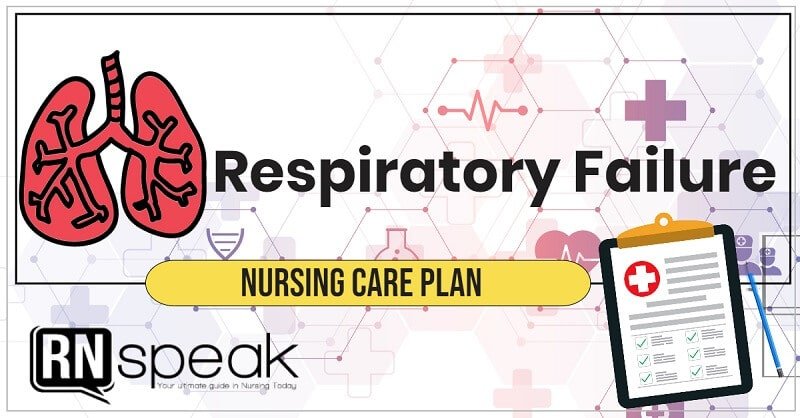Acute respiratory failure is a life-threatening condition that can occur suddenly and requires prompt medical attention. It is defined as the inability of the respiratory system to provide adequate oxygenation and/or carbon dioxide elimination, leading to respiratory distress and hypoxemia. Nursing diagnosis and care plans play an essential role in the management of patients with acute respiratory failure. In this article, we will discuss the nursing diagnosis and care plan for patients with acute respiratory failure.

Assessment and Diagnosis
The assessment of patients with acute respiratory failure should include a thorough history and physical examination, as well as monitoring of vital signs and oxygen saturation levels. Diagnostic tests such as arterial blood gas analysis, chest x-rays, and pulmonary function tests may also be necessary to determine the severity and underlying cause of the respiratory failure.
The nursing diagnosis for patients with acute respiratory failure may include:
- Ineffective Airway Clearance
Ineffective airway clearance refers to the inability to clear secretions or foreign objects from the airway, leading to respiratory distress and potential airway obstruction. This can be caused by factors such as impaired cough reflex, thick or copious secretions, or bronchospasm.
Nursing interventions for ineffective airway clearance may include:
- Encourage coughing and deep breathing exercises to promote airway clearance.
- Administer bronchodilators or nebulized medications to reduce bronchospasm and improve airway patency.
- Provide chest physiotherapy, such as percussion and vibration, to help loosen and mobilize secretions.
- Suction the airway as needed to remove excess secretions or mucus.
- Impaired Gas Exchange
Impaired gas exchange refers to the inadequate oxygenation and/or elimination of carbon dioxide in the body, leading to hypoxemia and hypercapnia. This can be caused by factors such as pulmonary edema, atelectasis, or ventilation-perfusion (V/Q) mismatch.
Nursing interventions for impaired gas exchange may include:
- Administer supplemental oxygen to improve oxygen saturation levels.
- Monitor arterial blood gas levels and adjust oxygen therapy as needed to maintain adequate oxygenation and ventilation.
- Position the patient to optimize oxygenation, such as elevating the head of the bed or turning the patient to improve ventilation-perfusion matching.
- Administer medications such as diuretics or bronchodilators to treat underlying conditions that may be contributing to impaired gas exchange.
- Anxiety
Anxiety is a common complication of acute respiratory failure, as patients may feel a sense of suffocation or fear of impending respiratory arrest. This can lead to increased respiratory distress and further exacerbate the respiratory failure.
Nursing interventions for anxiety may include:
- Provide reassurance and emotional support to help alleviate feelings of panic and anxiety.
- Administer medications such as benzodiazepines or opioids to reduce anxiety and promote relaxation.
- Teach relaxation techniques such as deep breathing, guided imagery, or progressive muscle relaxation to help patients cope with anxiety and promote relaxation.
- Risk for Infection
Patients with acute respiratory failure are at increased risk for respiratory infections due to impaired airway clearance and compromised immune function. This can lead to further respiratory compromise and potential respiratory failure.
Nursing interventions for risk for infection may include:
- Encourage and assist with frequent hand washing and good personal hygiene to reduce the risk of infection.
- Use appropriate infection control measures such as isolation precautions, as needed.
- Administer antibiotics or antiviral medications as prescribed to treat or prevent infection.
- Monitor for signs and symptoms of infection, such as fever, cough, or increased sputum production.
Care Plan
The care plan for patients with acute respiratory failure should be individualized based on the patient’s underlying condition and specific nursing diagnoses. The following is an example of a care plan for a
patient with acute respiratory failure:
Nursing Diagnosis: Ineffective Airway Clearance
Goal: The patient will maintain clear airway and effective breathing.
Interventions:
- Assess cough, sputum production, and lung sounds regularly.
- Encourage coughing and deep breathing exercises to promote airway clearance.
- Administer bronchodilators or nebulized medications to reduce bronchospasm and improve airway patency.
- Provide chest physiotherapy, such as percussion and vibration, to help loosen and mobilize secretions.
- Suction the airway as needed to remove excess secretions or mucus.
- Monitor for signs of respiratory distress, such as tachypnea, retractions, or use of accessory muscles.
Evaluation:
- The patient’s airway remains clear, and breathing is effective.
- Lung sounds are clear, and the patient is able to cough up secretions.
- The patient does not exhibit signs of respiratory distress.
- Asthma Nursing Care Plans: A Guide
- Nursing Care Plan for Ineffective Breathing Pattern: Diagnosis and Interventions
- The Four Waves of Feminism
- How I Manage My Time – 10 Time Management Tips
- How to Remembering Everything You Read: Tips & Tricks
Nursing Diagnosis: Impaired Gas Exchange
Goal: The patient will maintain adequate oxygenation and ventilation.
Interventions:
- Assess respiratory rate, depth, and effort regularly.
- Administer supplemental oxygen to maintain oxygen saturation levels above 90%.
- Monitor arterial blood gas levels and adjust oxygen therapy as needed to maintain adequate oxygenation and ventilation.
- Position the patient to optimize oxygenation, such as elevating the head of the bed or turning the patient to improve ventilation-perfusion matching.
- Administer medications such as diuretics or bronchodilators to treat underlying conditions that may be contributing to impaired gas exchange.
- Monitor for signs of respiratory failure, such as worsening hypoxemia or hypercapnia.
Evaluation:
- The patient maintains adequate oxygenation and ventilation.
- Oxygen saturation levels remain above 90%.
- Arterial blood gas levels are within normal limits, and respiratory effort is stable.
Nursing Diagnosis: Anxiety
Goal: The patient will be able to cope with anxiety and fear related to respiratory distress.
Interventions:
- Provide reassurance and emotional support to help alleviate feelings of panic and anxiety.
- Administer medications such as benzodiazepines or opioids to reduce anxiety and promote relaxation.
- Teach relaxation techniques such as deep breathing, guided imagery, or progressive muscle relaxation to help patients cope with anxiety and promote relaxation.
- Encourage the patient to express fears and concerns related to respiratory distress.
Evaluation:
- The patient is able to cope with anxiety and fear related to respiratory distress.
- The patient reports feeling less anxious and more relaxed.
- The patient is able to use relaxation techniques to reduce anxiety.
Nursing Diagnosis: Risk for Infection
Goal: The patient will not develop respiratory infections.
Interventions:
- Encourage and assist with frequent hand washing and good personal hygiene to reduce the risk of infection.
- Use appropriate infection control measures such as isolation precautions, as needed.
- Administer antibiotics or antiviral medications as prescribed to treat or prevent infection.
- Monitor for signs and symptoms of infection, such as fever, cough, or increased sputum production.
- Ensure that equipment such as nebulizers or oxygen delivery systems are properly cleaned and disinfected.
Evaluation:
- The patient does not develop respiratory infections.
- The patient remains afebrile, with no signs or symptoms of infection.
- Infection control measures are effective in preventing the spread of infection.
Conclusion
Acute respiratory failure is a serious medical condition that requires prompt diagnosis and management. Nursing diagnosis and care plans play a critical role in the care of patients with acute respiratory failure, as they help to identify potential complications and guide interventions to promote optimal respiratory function. By using a systematic approach to assessment, diagnosis, and care planning, nurses can provide comprehensive care to patients with
Acute Respiratory Failure Nursing Diagnosis & Care Plan

Pay Someone to Do My Homework for Me
Find online help in writing essays, research papers, term papers, reports, movie reviews, annotated bibliographies, speeches/presentations, projects, presentations, dissertation services, theses, research proposals, essay editing, proofreading, Book reviews, article reviews, formatting, personal statements, admission essays, scholarship essays, application papers, among others.


 WRITE MY ESSAY NOW!
WRITE MY ESSAY NOW!